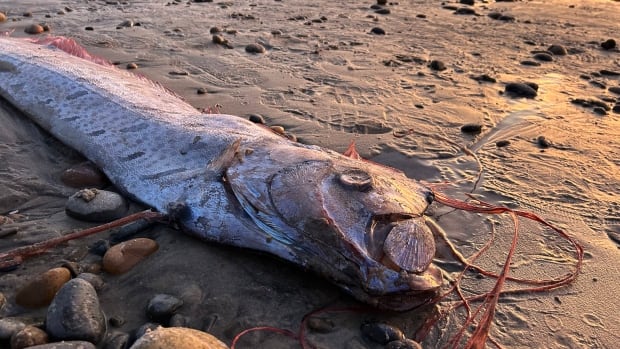As It Happens6:32These rare and mysterious deepsea fish are washing up in California, and no one’s sure why
Ben Frable considers himself a librarian of fish, and he just acquired a rare new specimen for his collection.
A 3.3-metre oarfish — a mysterious deepsea creature shaped like an eel — washed up earlier this month on the shores of California..
Thanks to the efforts of a keen-eyed PhD student, it will soon be added to Frable’s “fish library,” better known as the marine vertebrate collection at the Scripps Institution of Oceanography in San Diego, Calif.
“They’re very rare encounters for us,” Frable, the collection’s manager, told As It Happens host Nil Kӧksal.
“Getting to see a fresh specimen with a bright silver skin and that bright red fin, and just the full scale of it laid out, was pretty astounding.”
What do we know about oarfish?
Oarfish are massive and elusive fish with reflective skin who reside in the oceans’ depths all over the world.
Sometimes called “doomsday fish,” they are described in Japanese folklore as harbingers of disaster. It’s suspected they could even be the origin of the mythical sea serpents drawn throughout history on sailors’ maps.
The longest oarfish ever recorded was eight metres long, making them the biggest species of bony fish. Frable says some partial remains suggest they could reach as long as 11 metres.
Because they’re deepsea fish, humans don’t encounter them very often. Footage captured in recent years has shed some light on how they hunt — hovering vertically with their heads up, waiting for prey to swim by.
“Their main prey item, even though they do kind of look ferocious and get pretty big, are actually very small shrimp-like creatures called krill,” Frable said. “And then they have this very elaborate mouth that they can use to generate suction and slurp down these krill.”

There’s so much scientists still don’t know about oarfish, Frable said, and most of what they do know comes from studying their remains when they wash ashore.
Even that, Frable says, is rare. There are only 22 scientific recordings of the creatures washing up in California since 1901.
“That doesn’t give us a very large sample size,” he said. “So each specimen can really provide a lot of insight into these animals.”
That’s why he was so excited when he heard from Alison Laferriere, a Scripps PhD student, on Nov. 7.
Nearly swiped by surfers
Laferriere, who studies ocean acoustics, was walking her dog along the Grandview Beach in Encinitas, Calif., when she spotted an “elongated object” on the ground.
“As I got closer, I recognized it immediately,” she said. “I knew it was rare, so I knew it was important.”
She reached out to Frable, who contacted the U.S. National Oceanic and Atmospheric Administration to recover the fish and bring it in for a necropsy.

While she waited for the team to arrive, Laferriere stood guard over the grisly discovery.
“Shortly after I found it, I had gone back to my beach chairs to tell my fiancé about it, and I turned around and I see a surfer walking down the beach with the fish on the surfboard,” she said.
Laferreriere ran up him and his friends, explained the fish’s scientific value, and convinced him to put it back.
“He said, ‘I just wanted to put it in my friend’s van,'” she said, laughing. “I’m glad that I didn’t end up in someone’s van and then the garbage. I’m glad I was able to help.”
3rd in as many months
When oarfish wash ashore, Frable says, there tends to be more than one.
In fact, this is the third oarfish specimen to turn up in California in as many months, including one Scripps recovered in La Jolla in August.
“That might indicate that maybe these fish are moving around and are in a specific location for a year or two and then move away from that location,” he said.
“While they’re here, if they’re disoriented or sick or dying — we don’t really know why — they will eventually wash onto beaches. But we don’t have a good answer as to why that might be happening now in California.”

In 2013, the last time oarfish were turning up in California, marine biologist Milton Love told As It Happens he suspected a change in ocean currents brought the fish out of the calm deep waters they’re used to, and into more turbulent shallow waters.
“They’re just very delicate, and I think that they just died from trauma, basically,” he said at the time.
Nearly a decade later, he told the New York Times that’s still his best guess.
A bad omen?
Several of the creatures washed ashore in Japan ahead of the catastrophic 2011 earthquake, further entrenching their doomsday reputation. But a 2019 study by Japanese scientists found no correlation between quakes and oarfish appearances.
Frable he’s not worried the recent finds signify anything ominous.
“If there was something bad happening in the ecosystem, we wouldn’t just see a couple of random fish,” he said. “We’d see a lot of other organisms also showing up on our beaches.”
Laferreriere seemed similarly unfazed.
“I’m hoping, you know, it’s not specifically a bad omen for me,” she said with a laugh.





